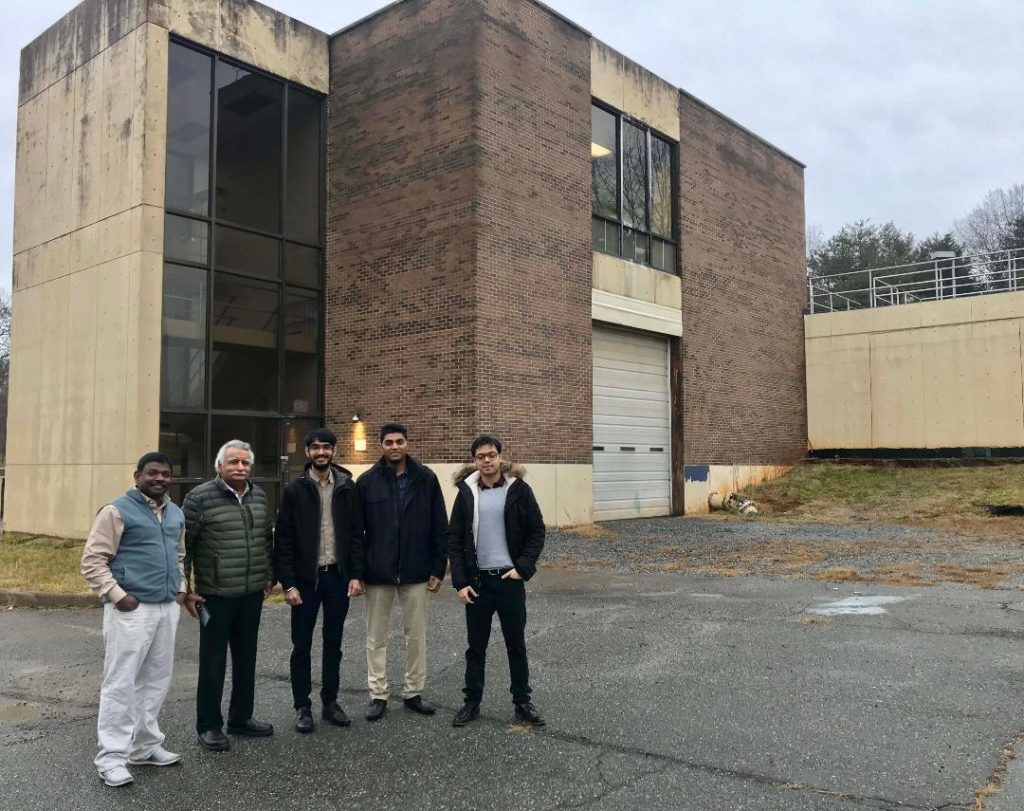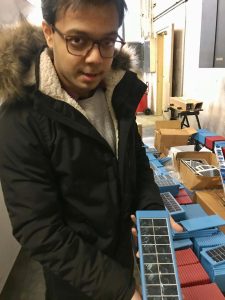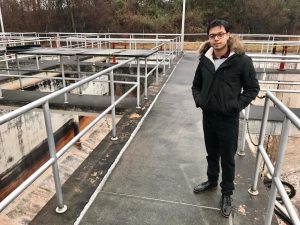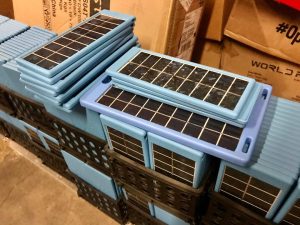
By Brandon Martin
When the Henry County Planning Commission recently approved a rezoning application for property located at 20 Water Plant Road in Ridgeway, it paved the way for a new company to locate there and become the cornerstone of a new energy park.
Advance Energy Solutions, Inc, a Vinton-based Renewable Energy Technology company, announced Friday that it purchased a building that once served as a Henry County Public Service Authority water plant and will locate its Solar & Wind Farm Protection control panel assembly operation to the facility.

The project listed in the application could be the first step towards renewable energy manufacturing in Henry County. It is also expected to rake in $1.6 million in additional revenue and 15 new jobs, according to data provided at the meeting.
The mind behind the project is Pugazhenthi “Pugal” Selvaraj, president of Advance Energy Solutions, a company that specializes in providing “design, development and deployment of the next generation smart grid solutions for solar and wind farms.”
In his application package to the Planning Commission, Selvaraj said he plans to manufacture electrical control panels for solar and wind farms, instruments for measuring and testing of electricity and electrical signals, and solar meters to test.
“Basically, I’m trying to make a green energy technology park where a control panel for a solar panel or wind farm can be assembled there,” he said, adding that he initially had the idea more than a year ago before delaying his search for a location because of the pandemic.
At the time, Selvaraj said there wasn’t available space but “luckily this property came open and I knew instantly that I could do my research and development there.”
Currently, research and development takes place in cohorts associated with Selvaraj. Some examples are educational institutes like Radford University and Virginia Polytechnic Institute.
“There are multiple reasons why the location (in Ridgeway) is perfect,” Selvaraj said. “One of the reasons is Henry County is very close to the Greensboro airport. It’s used easily as an access for international travel. That’s the primary one. Plus, it is closer to (U.S.) 220 and shipping is much easier. I can keep on adding for reasons why it’s a good spot, but I’d go on all day.”
Some of those reasons are opportunity-driven, according to Selvaraj.
“This is a part of Virginia that is not covered enough” with renewable energy products, he said. “We are in the race for solar energy. Currently, North Carolina is leading the race and Virginia is slowly behind it. When I researched, I found that Virginia doesn’t have very many solar or wind energy development companies.”
Selvaraj said he also chose the location due to its proximity to nearby universities.
“I wanted to be in Virginia, mainly because I graduated from Radford University,” he said. “I have a very long-standing relationship with them. We are planning on doing some research and development projects so I was looking for a place, wherein, I could have sustainability and access to other research.”

Not only will research and development take place at the former water plant, Selvaraj also wants the building to double for tourism.
“This is going to be called a Clean Energy Technology Park,” he said. “It’ll have the very concepts of solar and wind energy for customer awareness purposes. It’ll be modeled there and displayed for the customers to visit and see.”
Before proceeding, Selvaraj will have to wait for a final decision on his rezoning application from the Henry County Board of Supervisors, who are set to hold a public hearing on the matter in their upcoming Jan. 26 meeting.
“There’s still a lot of work to do. My plan is to start the technology park right away,” he said. “It’ll serve two functions. One is customer promotion and education awareness for customers in the area. Anybody looking for a carbon-free emissions building, this is one they will look to as an example. The second is the actual production of the control panels.”
He said he hopes to have all phases of the project completed by June. The following month, Selvaraj said he plans to hold “a small function” at the park with renewable energy developers throughout the state and country to bolster more development in the area.
“It’ll be after the July 4th celebration,” Selvaraj said. “My products like the control panel will be going out starting in August of the coming year. It’s going to be a lot of movement and a real challenge.”
In the beginning, Selvaraj said he would be looking to hire 10 operators and five support staff to serve management and maintenance functions.
“I’m looking for people that have a basic electrician’s background,” he said. “Basically, like a journeyman. If they are at that level, then great. If not, if they at least have the ability to obtain a journeyman certification, then I’ll have a training plan for them. It is very difficult to get a journeyman certification in Virginia, so I have a plan of my own where I can double up the team and train them to support the company’s needs.”
Spurred by excitement for his project, Selvaraj praised county officials and the Martinsville-Henry County Economic Development Corporation for their help through the application process.
“I have never seen as many good people as the county people that I’ve come across,” Selvaraj said. “When I was exploring the project, I wasn’t really sure what I was doing. All the people like Mark Heath at the Economic Development Corporation. They made it seem like somewhere I could make my home. That’s the feeling I had. Their responses were unbelievable.”
During the planning commission meeting, Lee Clark, director of Planning, Zoning, and Inspections for the county, said that Selvaraj would become an “asset to the community both as an employer and as an entrepreneur.
“He’s intending on spending quite a bit of money to retrofit this building into a facility where they will assemble the final products,” Clark said. “In my conversations with him, he has lots more ideas for other products. The developer (Selvaraj) is spending his own money for this. The county doesn’t have any incentives or money invested in this. He is doing it on his own.”
According to the Virginia Department of Environmental Quality, the state generates about seven percent of its electricity from renewable energy.
In 2019, Gov. Ralph Northam established three objectives for statewide energy production. The objectives were “By 2028, Virginia will achieve 5,500 megawatts of wind and solar energy. At least 3,000 megawatts of this target should be under development by 2022; By 2030, 30 percent of Virginia’s electric system will be powered by renewable energy resources; By 2050, 100 percent of Virginia’s electricity will be produced from carbon-free sources, such as wind, solar and nuclear.”
Dominion Energy is currently making large investments to achieve these goals through the Coastal Virginia Offshore Wind project. The project will “deliver up to 8.8 million megawatts per year of clean, renewable energy to the grid — powering up to 660,000 Virginia homes — and will avoid as much as five million tons of carbon dioxide emissions annually — the equivalent of planting more than 80 million trees,” according to the company’s website.
To have employees for the project, Virginia has created the Mid-Atlantic Wind Alliance, of which New College Institute in Martinsville will play a critical role of providing training in courses certified by the Global Wind Organisation (GWO). The courses are GWO Basic Safety Training and GWO Technical Training.
“Anybody that works on a wind turbine has to have these courses,” said NCI Interim Executive Director Karen Jackson. “With these two courses they have the basics to qualify for a job anywhere in the wind industry. To have NCI positioned to be the first place in the state (to offer the certifications) is a great spot to be in. I’d rather be on the cutting-edge of something instead of trailing the pack and the ground floor of the renewable energy industry is an exciting place to be. There is a need.”
In contrast to Virginia’s development of renewable energy through wind energy, North Carolina has made strides in solar production.
According to the 2018 North Carolina Clean Energy Industry Census, a total of 6,457 jobs were related to solar energy production in the state. The jobs span 553 firms and generated $2,939,070,419 for the state.
The state is making advancements in both customer-sited and utility-scale solar.
The North Carolina Sustainable Energy Association describes customer-sited solar as “technologies and services that convert sunlight directly into electricity through photovoltaic cells with a total generating capacity of less than two megawatts. This sector also includes solar thermal technologies that harness sunlight to meet thermal requirements for water or heating and cooling or create heat energy used to generate electricity for residential purposes. Customer-sited solar can be owned directly or purchased in part through a community resource or third party.”
Utility-scale accomplishes the same task but with a total generating capacity greater than two megawatts.
“Virginia is a little behind on the race for renewables compared to places like California, New York, or Massachusetts,” said Ved Jain, application engineer for the project. “Boston has really good policies for solar. Pretty much every house on one street will have solar panels going on. The concept isn’t as new to them as it is to this part of the country.”
Jain said that the project is forward thinking “where every house or business is actually a power generator and not just a consumer.
“Even if it’s just a simple mailbox office,” he added. “It’s going to produce power because the roof it has can absorb sunlight.”
During a tour of the facility, Jain demonstrated a few of the technologies that will be developed and how the building will be retrofitted to eventually become net-zero for consumption.
One item was a portable solar panel that comes with a USB connection.
“You have a charger on you pretty much all of the time,” Jain said. “The use of this isn’t for people like you and me. It’s used for someone on a deployment schedule. The use is for countries that have a lack of energy connection to the grid. It can even be used if you are going on a trip, and you’re going to a place where you don’t know if you’ll get electricity or not. A couple of these put together can charge your laptop.”
Jain said the portable line has the ability to charge an object at the same rate as household adapters.
“It’s more for active use than to act as a storage itself,” Jain said. “The thing is if we put a storage unit on it, it’ll be heavy and more expensive.”
If households access solar technology, Jain said that consumers could see a dip in their electricity bill each month.
“The grid offers this sort of deal and you can sell them back the excess electricity, so you don’t really need to store anything,” he said. “The need for storage comes when you are doing something on a really massive scale. Households don’t need as much. A couple of solar panels, in the afternoon, will produce electricity that you cannot use. So, you sell it back to the grid. What the grid does is they give you credit for the electricity that you just gave it back. And in the nighttime, when you are taking in excess, it’s going to take away from that bill.”
These types of technology will be implemented at the park as well, according to Jain.

Land immediately around the water plant will be used to erect “solar trees. What we are trying to do is make this building a net-zero building so whatever it takes is what it gives back,” Jain said. “We are going to balance all of those aspects like electricity, heating, and cooling. We are trying to make it a little dramatic, not like the ones you’d have on a solar farm.
“The thing about solar is it is just a little off from being ergonomically pleasing to the eye,” he said. “Imagine if we could put solar panels on a structure that would look like a tree. That would look a lot more appealing than just having a solar panel there. We are working on that design.”
Jain said the team would also be working on development of technologies to generate energy from parking lots.
“What a lot of people don’t recognize is the land below the parking is also a powerhouse,” he said. “How that happens is with a geothermal system. You have these pipelines, which are really thick pipelines, and they run deep into the ground. Probably less than 30-40 feet deep. The government provides incentives on the diggings normally. In doing that, your land would look just like it is right now, and you won’t know it, but your bills would go down.
In addition to the parking lot at the park, Jain said they would be creating a solar roof and attaching panels to streetlights.
With a research and development park along the border of the two states, Selvaraj is hoping to make Henry County integral to the future renewable energy development in both.



